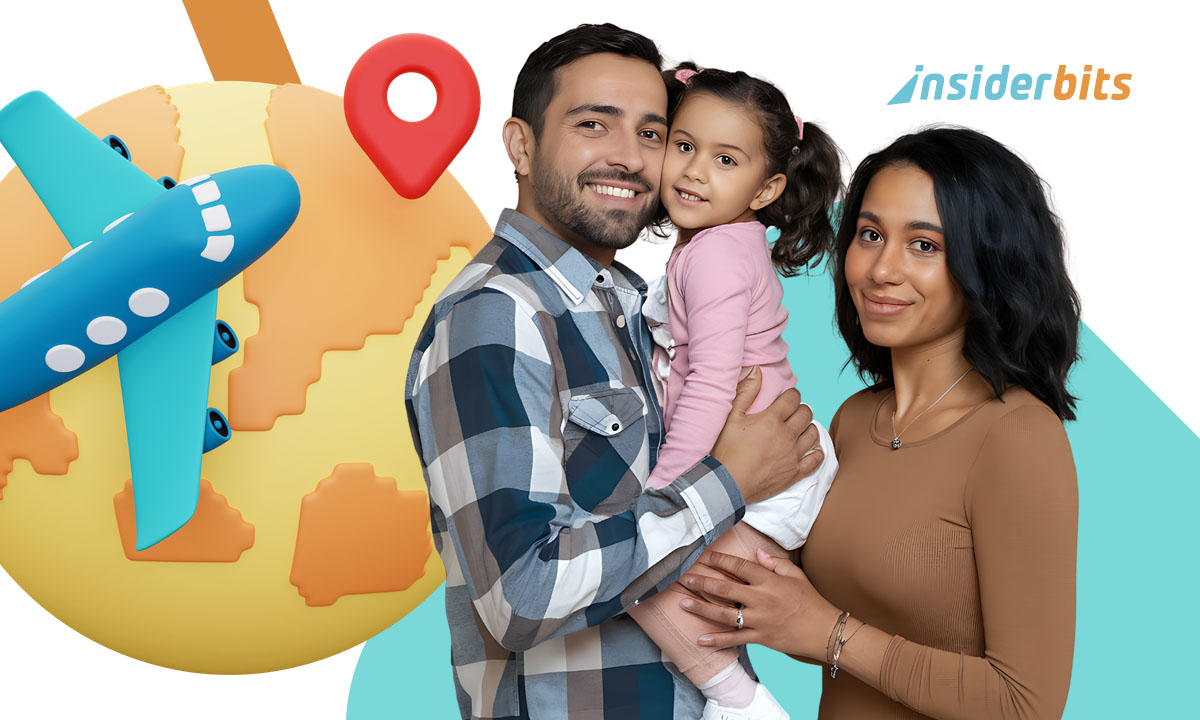For Immigrants With Children in the United States, things can be quite challenging, but there are crucial support programs available—many of which do not require citizenship. From food assistance to healthcare and education benefits, families may be eligible for help based on their income and residency, not just their immigration status.
Knowing what’s available can ease financial pressure and provide stability for your children. Understanding your rights is the first step toward accessing these resources safely. We’ll break down eligibility for programs like Medicaid, SNAP, and public school support, and provide tips on how to apply without risking your immigration process.
- Best Free Apps for Immigrants Starting Life in the US
- Top English Learning Apps for Immigrants in the US
- Top Platforms Offering Jobs for Immigrants in the US
Benefits for Immigrants With Children: What You May Qualify For
Navigating life in a new country can be challenging, especially when raising children. Fortunately, several government and nonprofit programs provide essential benefits for immigrants, even if they don’t have U.S. citizenship.
From food assistance to healthcare and educational support, these resources help families thrive while maintaining legal immigration status.
Contrary to common fears, accessing these benefits does not count as a “public charge” under current immigration rules—meaning they won’t affect green card applications or visa renewals.
If you’re an immigrant parent, here’s what you and your children may be eligible for.
Food, School, and Healthcare Programs You Can Access
For immigrant families in the U.S., accessing basic necessities like food, education, and healthcare can be challenging—but multiple federal and state programs exist to help.
Below is a detailed breakdown of key assistance programs available to immigrant parents and their children, including eligibility requirements and how to apply.
Nutritional Assistance (SNAP & WIC)
Access to nutritious food is essential for every family, especially those with growing children.
Programs like SNAP (Supplemental Nutrition Assistance Program) and WIC (Women, Infants, and Children) offer vital support to help low-income households afford healthy groceries and essential items.
SNAP (Supplemental Nutrition Assistance Program)
- What it provides: monthly funds (via an EBT card) to purchase groceries at approved stores;
- Eligibility for immigrants:
- Legal permanent residents (green card holders) qualify after five years in the U.S., but exceptions exist for refugees, asylees, and children under 18;
- Some states (like California and New York) offer state-funded food assistance for undocumented families.
- How to apply:
- Visit your state’s SNAP website or local social services office;
- Use the SNAP eligibility pre-screener to check qualifications.
WIC (Women, Infants, and Children)
- What it provides:
- Nutritious food packages (milk, eggs, whole grains, baby formula);
- Breastfeeding support and nutrition counseling;
- Referrals to healthcare and social services.
- Eligibility for immigrants:
- No citizenship or legal status required—available to pregnant women, new mothers, and children under 5;
- Must meet income guidelines (varies by state).
- How to apply:
- Locate your nearest WIC clinic via the WIC official site;
- Bring proof of income, address, and children’s birth certificates.
Free or Reduced School Meals
- What it provides:
- Free or low-cost breakfast and lunch at public schools;
- Some districts offer summer meal programs.
- Eligibility for immigrants:
- No citizenship required—only proof of residency and household income;
- Children automatically qualify if the family receives SNAP or TANF benefits.
- How to apply:
- Contact your child’s school for an application (often available in multiple languages);
- Submit proof of income (pay stubs, tax returns, or benefit award letters).
Medicaid & CHIP (Children’s Health Insurance Program)
Medicaid
- What it covers:
- Doctor visits, hospital care, immunizations, emergency services;
- Prenatal care for pregnant women.
- Eligibility for immigrants:
- Legal residents qualify after a 5-year waiting period (waived for refugees and asylees);
- Undocumented children may qualify in states like California, New York, and Illinois under state-funded programs.
- How to apply:
- Visit Healthcare.gov or your state’s Medicaid office.
CHIP (Children’s Health Insurance Program)
- What it covers:
- Low-cost health insurance for children (check-ups, dental, vision).
- Eligibility for immigrants:
- Available to lawfully present children, even if parents are undocumented;
- Income limits are higher than Medicaid.
- How to apply:
- Apply through Healthcare.gov or your state’s CHIP program.
Additional Programs to Explore
- TANF (Temporary Assistance for Needy Families): cash aid for low-income families (eligibility varies by state);
- Head Start/Early Head Start: free preschool and early education for low-income families;
- LIHEAP (Low-Income Home Energy Assistance Program): helps with heating/cooling bills.
For a full list of programs, visit USA.gov’s benefits page.
Why These Programs Matter
Many immigrant families avoid applying for benefits due to fear or misinformation—but these programs exist to support children’s health and development, regardless of immigration status.
If you qualify, applying ensures your family has access to food, healthcare, and education.
For more guidance, see the National Immigration Law Center’s resource table.
How to Apply for Benefits Without Citizenship
Many Immigrants With Children hesitate to apply for assistance due to fears about their legal status. However, most programs do not require citizenship. Here’s how to get started:
- Check Eligibility: use this federal benefits table to see what you qualify for.
- Gather Documents: proof of income, residency, and children’s birth certificates are commonly needed.
- Apply Online or In-Person:
- SNAP/CalFresh: apply via GetCalFresh (California) or your state’s social services website.
- Medicaid/CHIP: visit Healthcare.gov or your local Medicaid office.
For step-by-step guidance, see our article on how to check government benefits.
What Documents Are Needed to Get Help
Applying for benefits as an immigrant can feel overwhelming, especially when gathering paperwork. However, having the right documents ready will make the process smoother.
Below is a detailed breakdown of what you’ll typically need to apply for food, healthcare, and school assistance programs.
Proof of Identity & Immigration Status (If Applicable)
While many programs do not require citizenship, some may ask for:
- For parents/guardians:
- Government-issued ID (passport, consular ID, driver’s license);
- Green card (if applicable);
- Work permit (EAD);
- I-94 Arrival/Departure Record (for refugees, asylees, visa holders).
- For children (if applying for benefits like Medicaid/SNAP):
- Birth certificate (translated if not in English);
- School records (for school meal programs).
Important: some programs (like WIC and free school meals) do not require immigration documents—only proof of residency.
Proof of Residency (Required for Most Programs)
You’ll need to show that you live in the state where you’re applying. Acceptable documents include:
- Lease agreement or utility bill (electric, water, gas) in your name;
- A letter from your landlord confirming your address;
- School enrollment records (for child-based benefits);
- Bank statement or pay stub with your address.
Proof of Income (For Needs-Based Programs Like SNAP, Medicaid, CHIP)
Programs that assist low-income families will ask for:
- Recent pay stubs (last 30 days);
- Tax returns (if self-employed);
- Proof of unemployment benefits (if applicable);
- Child support or alimony documents;
- Letter from employer (if paid in cash).
Note: If you have no income, you may still qualify—explain your situation to the caseworker.
Additional Documents for Specific Programs
For SNAP (Food Stamps):
- Social Security numbers (if you have them);
- Proof of expenses (rent, childcare, medical bills for elderly/disabled members).
For Medicaid/CHIP:
- Current health insurance information (if any);
- Medical bills (if applying for disability-related coverage).
For WIC (Women, Infants, and Children):
- Proof of pregnancy (doctor’s note) or child’s birth certificate;
- Immunization records (for children under 5).
For Free School Meals:
- School enrollment form;
- SNAP or TANF case number (if applicable).
What If You’re Missing Documents?
Don’t let missing paperwork stop you from applying. Many agencies can:
- Accept alternative documents (e.g., a sworn statement if you lack a birth certificate);
- Help you request replacements (like Social Security cards);
- Provide interpreters if forms are only in English.
Tip: call the program’s office before applying to confirm exactly what you need.
Common Myths About Public Benefits and Immigration Status
Navigating public benefits as an immigrant can feel overwhelming—especially with so much misinformation circulating.
Many families avoid applying for help they’re legally allowed to receive due to fear or confusion about how it might affect their immigration status.
Myth 1: “Applying for benefits will get me deported.”
False. Most programs do not share information with immigration enforcement.
Myth 2: “Only citizens can get help.”
False. Many benefits are available to legal residents, refugees, asylees, and even some undocumented families (especially for children).
Myth 3: “Using benefits will hurt my green card application.”
False. Current policies exclude food, healthcare, and housing aid from public charge determinations.
For official clarification, review this NILC resource.
Final Thoughts
Raising a family in a new country shouldn’t mean struggling alone. From food assistance to healthcare, these benefits for immigrants with children provide crucial support—legally and safely. If you qualify, don’t hesitate to apply.
For a full breakdown of available programs, visit the National Immigration Law Center’s guide. Your family’s well-being matters.





